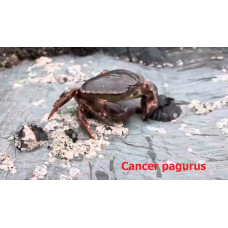An infraorder of ten-legged crustaceans living in salt and fresh water.
Crabs (Brachyura) are short-tailed crayfish of the order Decapoda. The width of the cephalothorax is up to 60 cm. The shell of the cephalothorax is broad, flattened in dorsoventral direction. The head is small, hidden in a recess under the shell. Abdomen short, tucked under the cephalothorax. Over 4000 species. They live in marine and fresh waters, the most numerous in the tropical zone. Many Brachyura are objects of fishing.
Sometimes reach huge sizes: crabs Macrocheira kaempferi, inhabiting the coast of Japan, reach a weight of 19 kg with a leg span of up to 3.8 meters. The head of the crabs is small, short abdomen symmetrical and tucked under the jawbreast. The cephalothorax is strongly expanded and flattened. The width of the carapace (part of the carapace, a continuous shield covering the body from above) is usually greater than its length and is more strongly protruded to the sides, causing the gill cavity on the cut has the appearance of a triangle. Both antennae are short. Coloration can be very different, sometimes very bright. Pigments are located in the outer layer of the cuticle or in chromatophores in the subcutaneous connective tissue. The distribution and concentration of pigments in chromatophores is hormonally regulated. The coloration of the cuticle is determined by the astaxanthin-protein complex, which gives a characteristic red color when denatured (e.g. when boiled).
In front of the pereopods there is a mouth field completely covered by III maxillipedes, due to which other parts of the mouth apparatus are not visible. I pereopods are characterized by powerfully developed claws, and the sizes of the left and right claws may differ greatly (heterochslia), as in the beckoning crab. The larger claw ("crushing claw") is stronger and adapted for crushing prey, while the smaller claw is used for cutting.
The pleon is a small, narrow and short appendage tucked forward under the cephalothorax. Pleopods are not used for swimming. In females they are necessary for egg attachment. Males have a petasma (transformed endopodites of the first pair of pleopods), which is formed only from the first pair of pleopods. Tail fan is absent, therefore swimming backwards by means of sharp reductions of pleon in crabs is impossible. In case of reduction of pleon, the center of gravity is shifted under the cephalothorax, between the pereopods. This change has an advantage for walking and running, as the crab does not need to pull up the rear of the body.
Because of this, crabs are able to move forward, sideways, and backward with ease. By the appearance of the carapace, it is easy to recognize how a particular species of crab moves: mostly sideways or in all directions. In the second case, the sternites are radial, in the first - located at right angles to the longitudinal axis of the body. If such a crab tries to move quickly, it runs sideways to the front. Ghost crabs (Ocypode), living in the intertidal zone on tropical coasts are able to develop a speed of more than 1.6 m / s. In general, crabs live on the surface of the ground, but some can climb trees, while others can dig deep and branching burrows. A number of species have gained the lost ability to swim by transforming both terminal segments of the V pereopod into broad "oars" (swimmer crabs).
The abdominal limbs in the male (1-2 pairs) are converted into a copulatory organ, in the female (4 pairs) serve for carrying eggs. They live in seas, freshwater bodies and on land.
The sensory organs of crabs are various sensitive bristles, statocysts and eyes. Statocysts are chitin-lined depressions of the surface of the basal segment of the antennal antennae I. In it lays statolith, secreted by a special tissue or brought into the statocyst with the help of a claw. Facet eyes are located on stalks and are very mobile.
Respiration is carried out by gills located on the border of the thoracic leg and trunk. Their number can reach up to four. The intestine is represented by a straight tube and consists of the stomodeum, a short section of the midgut and the proctodeum. The stomodeum in crabs is divided into a short esophagus and a large-sized stomach with an anterior chamber (cardiac or chewing section) and a posterior chamber (pyloric or filtering section). The mouthparts of crabs tear off pieces of food but do not pulverize them. Captured by claws food is transferred by 3 pairs of maxillipedes to the front part of the mouth apparatus and held there by mandibles. Small particles are then broken off from the food. Most crabs are predators or scavengers, cannibalism is also widespread. Freshwater and terrestrial species feed mainly on plants, but also eat carrion.
Crabs
Tags: crabs



